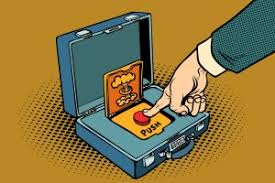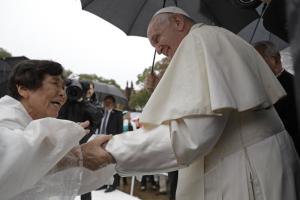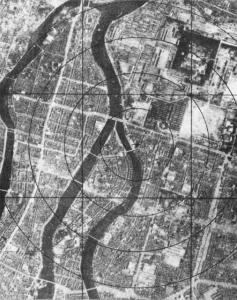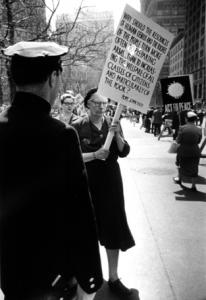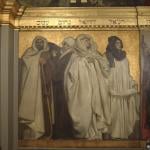
Seventy-seven years ago the United States unleashed the power of the atom against two population centers in Japan. Since then practically all the typical American heard about the morality of these acts was how necessary it was to end the war and prevent even more killing. Contrary voices, including those of religious figures (see this post), scientists, generals, and other military advisers were missing from the history that I and most Americans learned in school. It was an “end justifies the means” type of morality we absorbed. The next post will condemn, in line with Catholic teaching, this “consequentialist” thinking about the morality of the bomb. It will also question the strategy of deterrence that supposedly keeps such weapons from being used again. This post will show the flaws of the thinking that tried to justify the bomb from a purely pragmatic, rather than ethical point of view.
Second in a series of posts on “Nuclear Weapons, the World, and the Church.”
The stories we were told vs. the facts—First Story
On August 9, 1945, President Harry Truman addressed the American people. Aware of the extraordinary destructive power of the atom bomb, he also knew Americans would need a way to justify the bomb. Perhaps it was morally OK to use an atomic weapon in war. In this first story, as I will call it, Truman claimed that the bomb destroyed a military target:
The world will note that the first atomic bomb was dropped on Hiroshima, a military base. That was because we wished in this first attack to avoid, insofar as possible, the killing of civilians. (From “70 Years Later, We Still Haven’t Apologized for Bombing Japan” in The Nation. This article is my source for details in this post unless otherwise noted.)
The facts don’t quite match what Truman claimed. Hiroshima did, indeed, contain facilities for manufacturing weapons of war. But mostly it housed ordinary citizens. Truman knew that innocent lives were snuffed out – closer to 100,000 than zero. The Nation article opines, “… if Hiroshima was a ‘military base,’ then so was Seattle.”
By the time Truman spoke, a second bomb had been dropped in the city of Nagasaki. (It’s possible Truman did not know this.) Credible estimates of civilians killed in both bombings vary from 110,000 mortalities to 210,000. (Bulletin of the Atomic Scientists) These figures do not include later (but foreseeable) deaths from radiation sickness.
Saving civilians was not the reason for the cities chosen. In the month before the bombings, Secretary of War Henry Stimson evidenced a desire for this atomic weapon to “show its strength.” For that he needed a city that hadn’t already been devastated by bombing. Hiroshima and Nagasaki were two of the few left. Non-nuclear firebombings destroyed 67 Japanese cities.
The stories and the facts—Second way we try to justify the bomb
Truman gave us another story in that August 9 speech, The Nation article reports. The Japanese attacked us without warning at Pearl Harbor, he said. They starved, beat, and executed American prisoners of war. They “abandoned all pretense of obeying international law of warfare.” Conveniently, Truman doesn’t apply the “law of warfare” to the annihilation of cities. But he continues with the story that became a crystal clear justification, in American eyes, for the only uses of nuclear weapons in war:
We have used [the atomic bomb] … in order to shorten the agony of war, in order to save the lives of thousands and thousands of young Americans.
This number of American lives “saved” by the bomb grew with time. After his initial “thousands and thousands,” Truman in 1955 wrote that invading Japan would have cost half a million Americans and at least that many Japanese. In 1991 President George H. W. Bush praised Truman’s “tough, calculating decision,” which saved millions of Americans.
This is the story that I learned as a school child in the 1950’s. It is the go-to story that for most Americans still serves to justify the bomb.
The facts of the matter belie the story. Before the bombing military experts estimated the number of American lives that would be lost in a potential invasion—40,000. Several World War II military commanders opposed using the atomic bomb. The Nation reports:
Six of the seven five-star generals and admirals of that time believed … that the Japanese were already defeated, knew it, and were likely to surrender before any American invasion could be launched.
Admiral William Leahy called the bomb “barbarous” and against “every Christian ethic I have ever heard of and all of the known laws of war.” General Dwight D. Eisenhower also had moral objections.
The unspoken story and the Smithsonian Gag Order
Some advisers told Truman a way to end the war quickly would be to drop the unconditional surrender demand and let Japan keep the emperor. “Truman rejected that advice, only to grant the same concession after the nuclear attacks,” The Nation says.
An honest, unspoken reason Truman decided as he did is worry about the Soviet Union. The USSR was about to enter the war against Japan. Delay in ending the war, Truman thought, would give our prospective Cold War enemy greater claim to East Asian territory.
All of these facts were in the hands of the Smithsonian’ National Air and Space Museum in 1996. The museum planned to mark the 50th anniversary of the end of World War II with an exhibit that would provoke unaccustomed serious thinking. Displays would have included:
- the fuselage of the Enola Gay, the plane used to drop the bomb on Hiroshima,
- debates and disagreements about the bomb’s use,
- the long-term consequences,
- “heartrending objects”—“a schoolgirl’s burnt lunchbox, a watch dial frozen at the instant of the bomb’s explosion, a fused rosary, photographs of the dead and dying.”
The Nation reports:
None of this [program] happened. The exhibit was canceled after a storm of protest. When the Air Force Association leaked a copy of the initial script to the media, critics denounced the Smithsonian for its “politically correct” and “anti-American” “revision” of history. The exhibit, they claimed, would be an insult to American veterans and fundamentally unpatriotic.
The U.S. Senate unanimously condemned the exhibit. Such is the misguided spirit that also today goes by the name “patriotism.” Just like then it’s difficult for some to tell the truth—about racism, the last election, or America’s role internationally. Republicans, who accept the truth about the 2020 election earn the “traitor” label if they say it.



